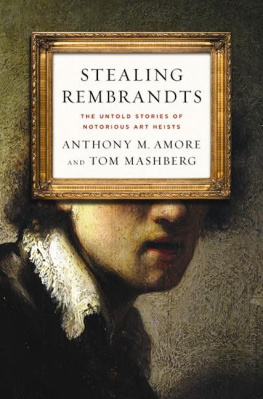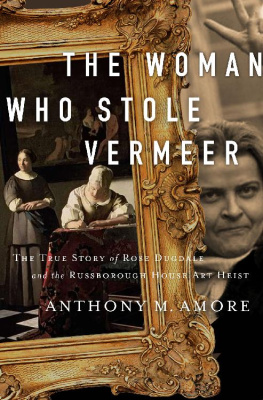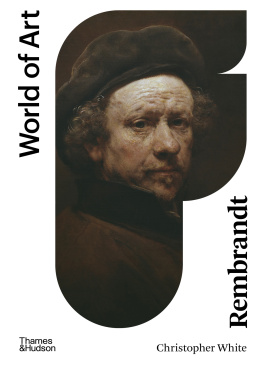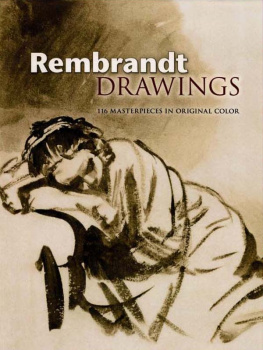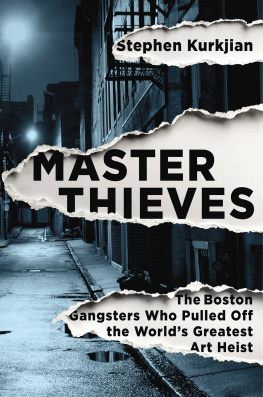STEALING REMBRANDTS
STEALING
REMBRANDTS
THE UNTOLD STORIES OF
NOTORIOUS ART HEISTS
Anthony M. Amore
and
Tom Mashberg
The author and publisher have provided this e-book to you for your personal use only. You may not make this e-book publicly available in any way. Copyright infringement is against the law. If you believe the copy of this e-book you are reading infringes on the authors copyright, please notify the publisher at: us.macmillanusa.com/piracy.
For Gabriela and Alessandra.
This book cannot hold the words Id need
to describe how much I love you.
A. A.
To my mother, Francesca Lack
T. M.
CONTENTS
AUTHORS FOREWORDS
AN INVESTIGATORS JOURNEY
A Rembrandt is the jewel of most any museums collection, and its loss can be a staggering blow. When I joined the Isabella Stewart Gardner Museum (ISGM) in Boston as security director in the fall of 2005, I made it my mission to recover the 13 works of art, including three Rembrandts, stolen in the dead of night on March 18, 1990. Today, it remains the greatest unsolved art heist in the world, and the unsurpassed Rembrandt van Rijn is at the heart of it. More than one seasoned investigator told me that, to find the art, I would have to eat, sleep, and drink the case and experience heartbreaks along the way. They were certainly right. For me, part of it included studying the extensive modern history of Rembrandt heists.
Of course, my first duty as security director was to shore up the safety of the entire Gardner collection. Because of the theft, many had accused the ISGM of lax security. I quickly found not only that this was unfair, but that the standards, personnel, and technology at the Gardner were at least as goodand usually betterthan those in place at other institutions. I was gratified to find that the leadership and staff at the museum, from Executive Director Anne Hawley and the museums trustees, to the conservators, archivists, and gallery guards, were committed to giving me the tools, support, and funds necessary to ensure the security of Mrs. Gardners amazing possessions. The ISGM now features robust and cutting-edge safeguards, and even as it expands into the 2010s with a bold new wing, I believe it is prepared for the security challenges of today and the future.
Having seen to it that the museum was a sanctuary as well as a showplace for its art, antiquities, and other great artifacts, I directed my attention to the recovery of the stolen works. It is in my nature to become obsessed with a mission, diving headfirst into all available literature, talking to all those with a connection to a case, and reaching out to experts and law enforcement officers.
My quest began with a reexamination of all aspects of the Gardner theft and the years of subsequent investigation. This meant gathering and analyzing every pertinent document received or created by the museum over a 15-year period. I informed the director that I would need all her files, notes, and correspondence related to the theft, and I told the museums staff that anything they retained on the matter was to be handed over to me. Everyone was eager to comply, and I found that the museums records on the theft and the 13 stolen itemsthe vital data of the casehad been carefully maintained.
I spent months reading thousands of pages of leads, theories, letters, articles, memorandums, court papers, and other materials. I built a database of the information contained in these records. Names, dates, addresses, phone numbers, email addresses, vehicle information, birth dates, death datesall this had to be catalogued to ensure that no detail, however small, would be overlooked. This method continues to serve me well in comparing old information to newer leads.
The next major undertaking was gathering intelligence from current and retired law enforcement sources of good reputethose familiar with the case and those experienced in the worlds of local and international art crime. Equally necessary was interviewing knowledgeable members of the criminal underworld as well as their families, friends, and associates. I also sought out the journalists who have made a study of the case, among them my coauthor, Tom Mashberg.
Another pivotal step in my investigation of this 20-year puzzle was researching how art criminals operate, their method, or MO. Combining the intelligence I gathered and the reams of information available online and in the memories of old art experts, I examined crimes that bore even the slightest resemblance to the Gardner case. I searched through decades of newspaper records, using the Boston Public Library as well as the archives at major local and national newspapers. I had many burning questions. For instance, because the Gardner thieves had dressed as police officers to trick a security guard into granting them entry, I wanted to know what other crimes were committed in Boston by men disguised in police uniforms, or in any uniforms. I also wanted to study robbery methods that were completely different from the Gardner robberythis would let me rule out certain criminals and keep a tighter focus.
One of the more intriguing characteristics of the Gardner heist is that two of the stolen paintings, The Storm on the Sea of Galilee (1633) and A Lady and Gentleman in Black (1633), both by Rembrandt, were cut from their frames. When an artist paints, the canvas is held taut by a stretcher, and that stretcher is then packed inside the frame. In this theft, both the stretchers and frames were left lying on the museum floor. Why had the thieves done this? Was it because the frames and stretchers, all combined, were too heavy to carry out? Possibly, but there were two thieves on hand, both described by the guards as young and healthy, and they spent a leisurely 81 minutes in the museum. They had all the time they needed to carry away the paintings rather than commit what can be described only as a witless act of desecration: slicing two Rembrandt canvases from their stretchers. Why risk irreparable damage? Were they so unschooled as to imagine they could manhandle the canvases without wreaking destruction on the paintings? That alone is a key insight into the culprits. Thieves schooled in art would have done no such thing. Moreover, the robbers anticipated that they were going to cut some paintings from their frames. Why else would they have brought along an instrument that was sharp and sturdy enough to slice through stiff, varnished paint and linen canvas? Two other major art thefts in Massachusetts (both involving Rembrandts, as the following chapters will show) were pulled off more than 15 years before the Gardner crime without anyone resorting to cutting canvases. Why do so now? Had these thieves learned their lessons in theft outside Massachusetts? Was this their first art crime?
To answer these questions, I needed to examine art thefts spanning the globe and learn how common it was for paintings to be cut or removed from their frames, both before and since 1990. That examination led me to obscure art thefts committed in a similar fashion. I set out to learn whether this act was some form of signature, a telltale or forensic clue much like those left behind by repeat killers.
This kind of analysis is akin to the initial investigation conducted by a homicide detective. Aside from the obvious questions (e.g., victims identity, manner, and time of death), the detective has to consider the whole scene to get a jump on the identity of the perpetrator. When a murder victim is found still wearing an expensive watch or carrying a wallet full of money, robbery seems an unlikely motive. Similarly, items not stolen during a museum heist tell an investigator important things about the thieves. In the great majority of thefts, it has quickly become clear, the thieves were not art experts and had no shopping lists. This is because they often bypass works by great artists whose names may not be known in every householdRubens, Titian, Tintorettoyet whose works might be far more valuable than the small Rembrandt or Picasso or Manet they decide to remove. Or because they take a piece by an Old Master that is less significant than others by the same artist that hang nearby. Such missteps by thieves are routine. Assuming that doing so means the robbers had a strict shopping list rather than a case of cluelessness could easily throw investigators off-track.
Next page
